A Murderous Innkeep, a Hidden Lakeside Mansion, and Unbeatable Views—Northwest Nevada Is a Trip for Everybody
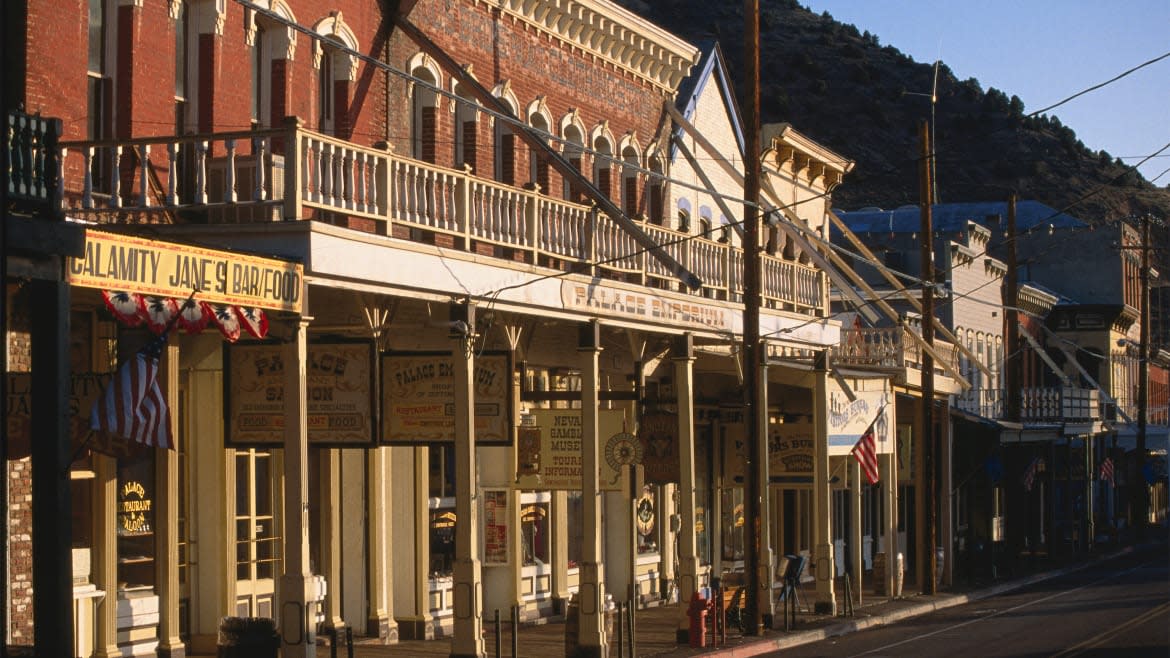
- Oops!Something went wrong.Please try again later.
- Oops!Something went wrong.Please try again later.
Laura D. Fair was seeing red on the evening of Nov. 3, 1870, when, dressed in a veil and cloak, she shot and killed the man she loved on a San Francisco ferry. At least that’s what her lawyers argued in court, the first plea of temporary insanity due to menstruation. She was let off, a verdict that showed, The New York Times declared, that the "very principles on which society and order are established seem to have crumbled away."
Fair was a hard-drinking, violent secessionist and an occasional prostitute. She also owned one of the most famous hotels in the Wild West.
The Tahoe House Hotel was its name, and it’s still around and recently renovated. I just spent a very comfortable night there. You’d hardly suspect anybody had ever been murdered in this bougie centerpiece of the once-violent mining boom town of Virginia City, now defanged, gussied up, and flaunting her historic wares to hundreds of thousands of tourists who pass through each year.
This fun little town in northwest Nevada was arguably once the richest in the world, but now it’s the historic ground zero of one of the best week-long loops a traveler can do in the U.S.—a trip that has something for nearly every traveler.
I started the trip in Reno, a classic American city whose halcyon days may be behind it but which most will find engaging for both its faded glory and current fight to renew itself. The railroads and mining initially drove Reno’s growth in the latter half of the 19th century, but the statewide legalization of gambling and liberalization of divorce laws a few years before that turned Reno into a booming destination. Thanks to the opening of Native American casinos in California and the supremacy of Las Vegas in the south, Reno lost a lot of its stature as one of the gambling destinations. But there are still plenty of casinos in town, as well as new attractions like the artificial climbing wall at the top of the modern new Whitney Peak Hotel. I ate well while in town–elevated American fare at Liberty Food & Wine Exchange, and then when I sadly couldn’t get into James Beard-nominated Kwok’s, great artisanal pizzas at The Pizza Collective.
But the real star of Reno in my opinion is over on the campus at University of Nevada, Reno. There, at the end of a leafy quadrangle, sits the Keck Museum at the school’s Mackay School of Mines. Inside is a literal treasure hoard in the form of a significant chunk of the legendary Mackay silver dining set.
To try to make an exceptionally long story short, Virginia City was at the center of the Comstock Lode, the first major silver strike in the U.S. in 1859. That gusher of silver helped the U.S. win the Civil War, fund the development of San Francisco, and was largely why Nevada became its own state. (It was originally part of Utah.) George Hearst, father of publisher and castle-building William Randolph Hearst, made his initial fortune there. Then, in 1876 when many thought the land depleted, a second rush took place and made four Irish immigrants–John William Mackay, James Graham Fair, James Clair Flood, and William S. O'Brien–exceptionally wealthy even by Gilded Age standards. Those men and their children went on a building spree across the country that yielded some of the era’s most lavish projects: Rosecliff in Newport, Menlo Park’s Linden Towers, Harbor Hill on Long Island, the first Fairmont Hotel and the Flood Mansion in San Francisco, and more.
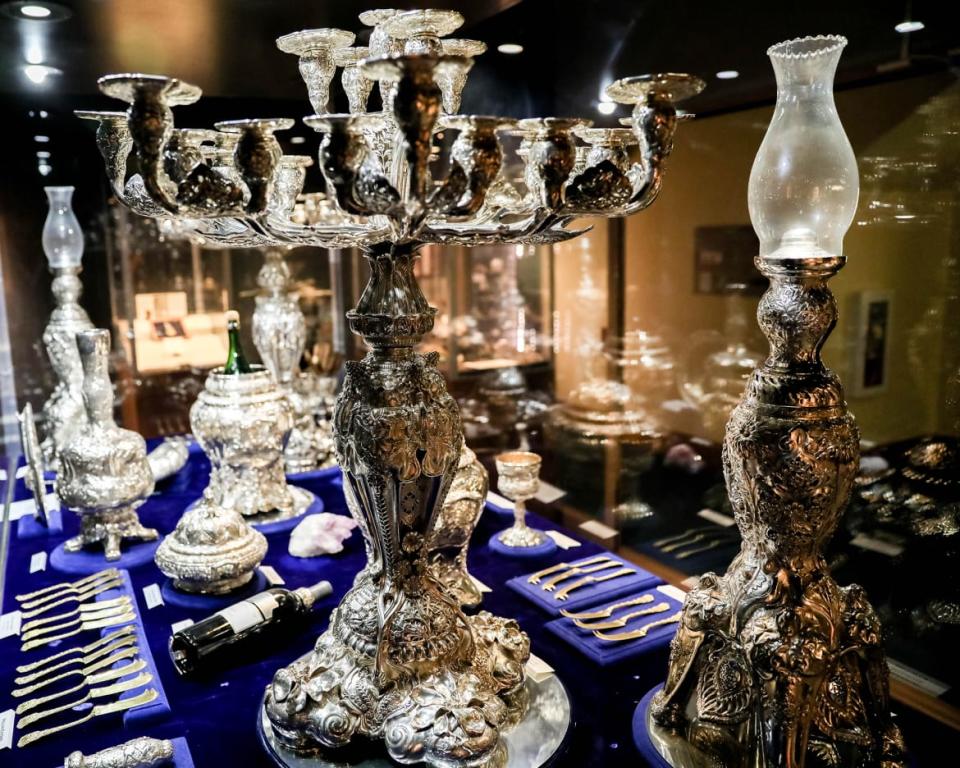
But the most outlandish project from these men was Mackay’s. He sent nearly half a ton (675 pounds) of silver in 1876 to Tiffany & Co. for a 24-person dining set. The list of items is staggering: 72 table forks, 72 dinner knives, 48 tablespoons, 48 breakfast knives, 24 egg spoons, 36 fish forks, 36 nut picks, 24 goblets, 48 salt spoons, and on and on. Some of the items, such as the 29-candle candelabras, were the largest of their kind ever made by Tiffany. Those candelabras, as well as the 125-pound centerpiece, were gifted to the museum by the family. So, too, were items like ornate vessels designed specifically to display celery, crumb trays that look like silver dust pans with accompanying knives fashioned to sweep up crumbs. The glittering collection also features cigar stands, a serving tray, soup tureen, ladles, ham holders, olive forks, champagne bottle holders, and a wine siphon. Other pieces from the set are in various collections worldwide.
The Mackay silver is held in the museum’s basement. Its main floor is devoted to its rock and mineral collection, full of cool items like petrified wood with opal mixed in, opalized plant vacuoles, Herkimer Diamond quartz (quartz crystals faceted by nature such that they resemble diamonds), tektites (a natural glass we’re not 100 percent positive how it got on Earth), and my new favorite, okenite, a cotton ball-looking mineral that someday I hope to touch. The mezzanine contains a display on the history of mines as well as Nevada’s fossils, from the giant footprints of land sloths once thought to be sandal prints from a giant human or creepy hundreds of millions of years old trilobites.
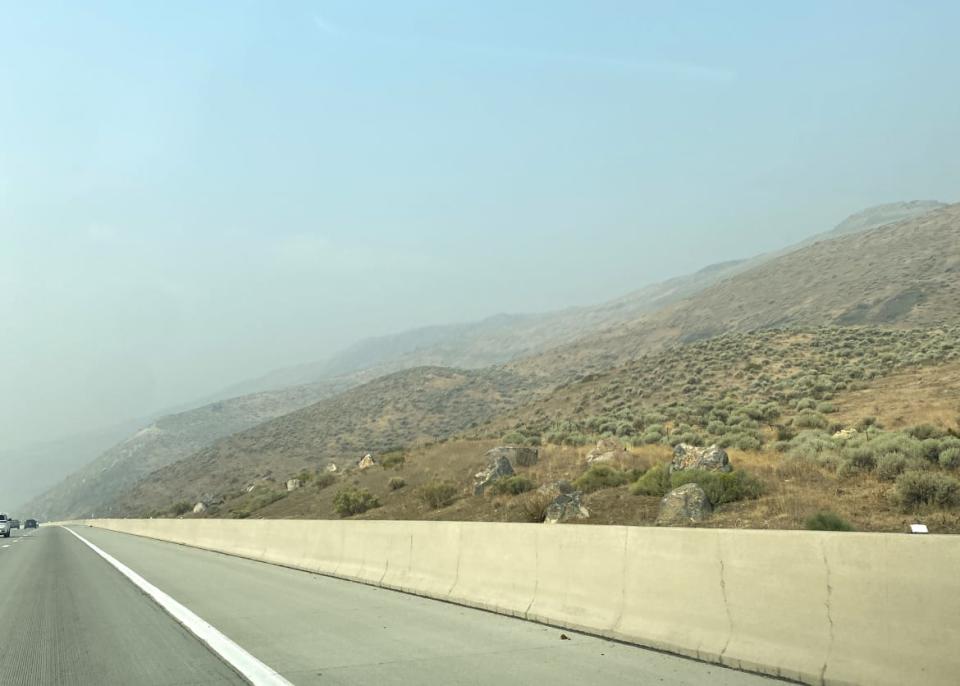
Leaving Reno after a night at the centrally located Renaissance Reno Downtown Hotel & Spa, I headed to the Carson Valley for the first leg of the loop. On my way out of town I stopped at Perenn, a shopping center bakery that inside is a light and airy millennial’s design dream. The food here was downright delicious. I went with a filling breakfast sandwich on a croissant followed by a cherry cruffin stuffed with chocolate cream. (I went a little overboard since the hike I was supposed to do was impossible–smoke from the Mosquito wildfire had the air quality index at a “hazardous” 351.)
Keen on something indoors, I headed to one of the most important historical sites in the region–the Stewart Indian School. At the end of the 19th century and into the 20th, the federal government opened numerous schools around the country where Native American children were enrolled–often against their will. There they were forcibly assimilated, forbidden to speak their language, hair cut, and often lived in abusive and cruel environments. Parents desperate to know their children were all right camped across the river, hoping to catch a glimpse.
Today the campus is largely preserved, and one of the buildings has been turned into a cultural center and museum. It’s small, but the exhibits are powerful. There are oral histories from members of the community who attended, stories about the achievements of students, and an informative timeline walking visitors through the past century and a half in this area. The center always has somebody from the community who has a connection to the school–most often an alum–on hand to talk about their experience with visitors.

Genoa, Nevada’s oldest settlement.
Leaving the school I headed to Genoa, which, like Nevada, has a pronunciation different from what you’d think. In this case, it’s Juh-no-ah. I would love a reaction video of somebody from Italy visiting this town and being told that. Driving to the town in the smoky haze, I passed rolling foothills clad in sagebrush, bitterbrush, Ponderosa pine, and jujube. You could almost think you’re in misty Scotland. Almost. This small town, whose (contested) claim to fame is “Nevada’s oldest settlement,” is a charming historic village nestled up against the mountains. To give you a sense of where you are, on the other side of those mountains is Lake Tahoe. The town is full of historic little spots like the Genoa Bar, the oldest in Nevada, where Raquel Welch’s brazier is hanging. According to legend, Welch came to the bar for respite from fans while shooting a film. Back then, there were numerous bras left behind by female patrons hanging in the bar. Welch was asked to leave hers–something she agreed to do only if all the others came down. The feisty, friendly, foul-mouthed barkeep there is exactly who you’d want to make a place like this feel alive and not hokey. And do pop over to the historical society, which has great exhibits on legendary cross-mountain mail carrier Snow-Shoe Thompson and Carson Valley native George Washington Ferris Jr., inventor of the eponymous wheel.
I spent the night at David Walley’s Hot Springs, a Holiday Inn, but when I arrived those hot springs were cloaked in a smoky haze. My dinner is across the valley a bit in Gardnerville, at JT Basque House, a long-running joint where if the decor doesn’t take you back in time, the hefty portions will. On the drive back, the rain rolled in and cleared away the smoke, giving me the view of the mountains here, a view that has drawn a number of people to this area for retirement or remote work. In the morning I had a gorgeous trail run on the Eagle Ridge Canyon Trail, a route that starts with a little incline and then runs horizontally at around 5,600 feet through Ponderosa Pine forest looking out over the whole valley.
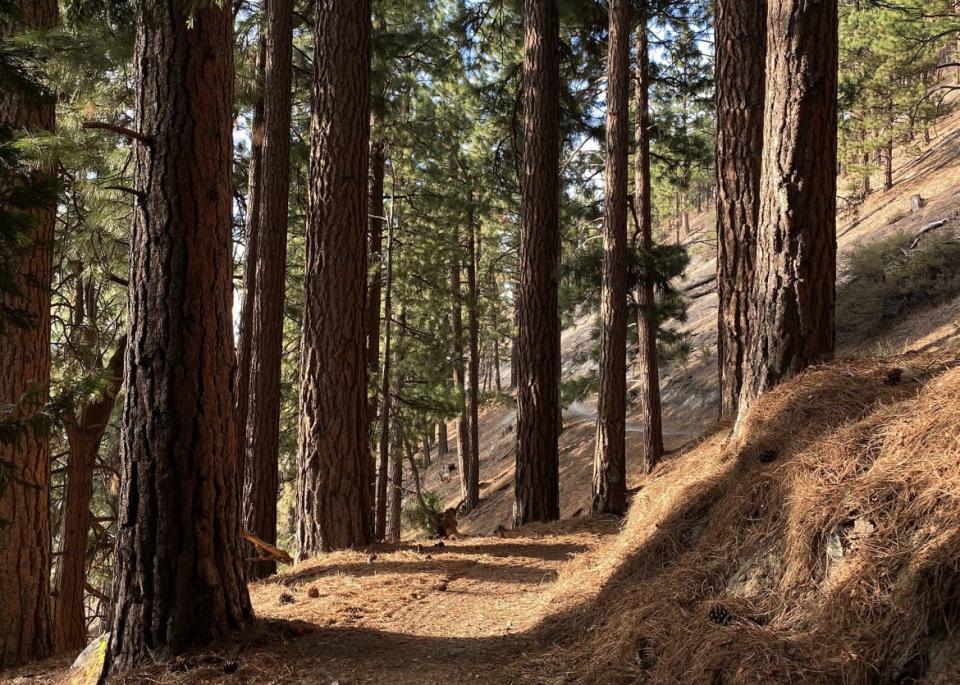
Not everybody in the family wants a trip built around history, however, and this circle also brings a bit of a bucket list item—Lake Tahoe. Strangely, this would be my first visit to the iconic lake that straddles the California-Nevada border. It’s a quick drive on vertiginous switchbacks to bring you to the lake from Genoa, but if you’re hungry, pop into Tahoe Bagel Company, a fantastic bagel spot with delicious breakfast sandwiches. (I would end up getting breakfast here twice.)
I won’t lie, I found my first day in Tahoe a little overwhelming, being unsure of where I was allowed to park and which beaches I could go to. But the lake’s beauty meets all one’s expectations, so I’ll definitely be back with more time and more knowledge. But even those who know Tahoe well don’t necessarily know one of its most beautiful and historic spots–Thunderbird Lodge.

The lodge and its pristine 6.5 acres of sloping waterfront grounds were once the home of mercurial and misanthropic PG&E heir George Whittel Jr. Whittell hired Frederic DeLongchamps, the Nevada architect who also designed the Mackay School of Mines, to build him a complex of picturesque cottages in the Rustic Style, much like the lodges gracing the national parks. Whittell was a hard-partying recluse–he kept a siren on the property to scare away visitors–who owned one of the sexiest boats ever made: a DC-2-inspired Honduran mahogany and stainless steel 55-foot powerboat. (Because of fears of it being seized during World War II, Whittell is believed to have kept it hidden and used it for less than 90 hours.) He had a pet lion, an opium room, bugged his entire house, and when a workman died while turning his old boathouse into a pool he sealed the room up immediately and never touched it again.
But in his quest for privacy, Whittell also accumulated more than 40,000 acres on the Nevada side of Lake Tahoe, unwittingly keeping this area largely unspoiled. Today, the lodge is run by a preservation group that offers tours and charters of the famed boat.
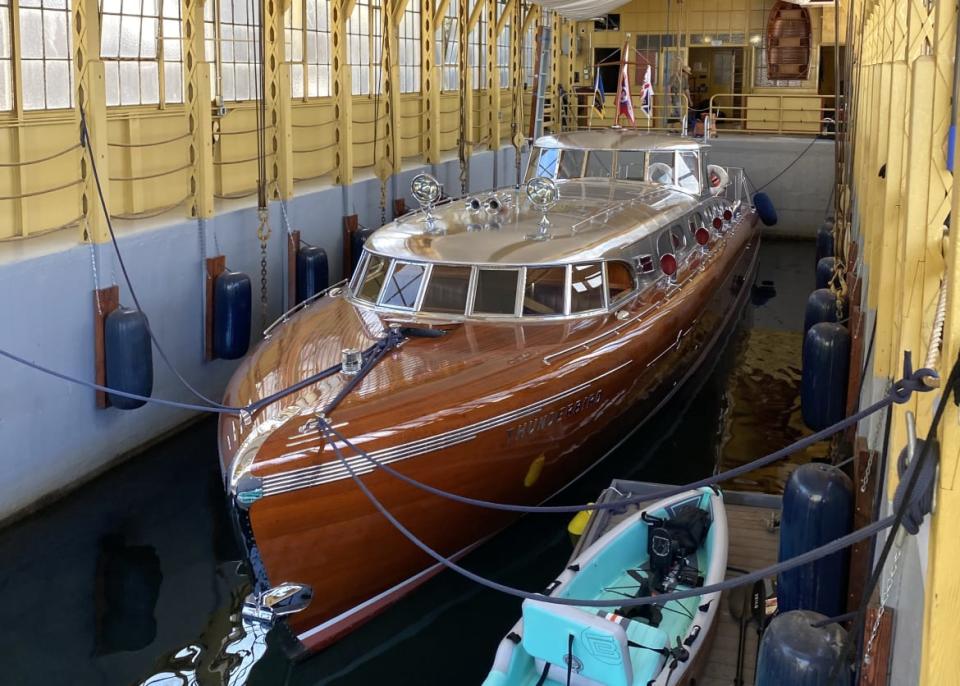
After a quick dip it was off to the Hyatt Regency in Incline Village, my home for the night. Set in the woods just off the water, the resort has easy access to both the shoreline as well as popular hikes like Monkey Rock with its sweeping views. Plus, the hotel gives you a s’mores kit which is just perfect for this end of summer trip.
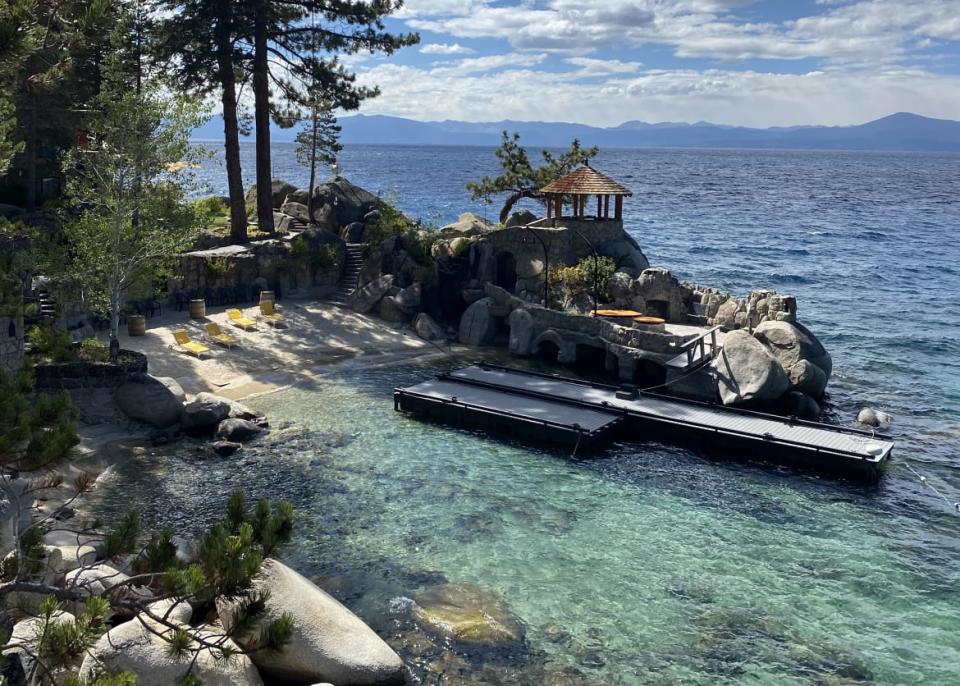
To get to Virginia City, and close out this loop, it was back through the mountains. I wasn’t sure what to expect. Would it be a sort of town as a museum a la Tombstone or Williamsburg? Or former mining town transformed into chic destination like Ouray and Terlingua? What I found was a place that defied categorizing but whose central goal seems to be to try anything and everything to have fun and get people here. There are Wild West shootout shows, camel races, mine shaft tours, ghost tours, outhouse races, train rides, saloons, gun shops, legal prostitution, and museums. Nearly every building has a juicy story, as I found out on my tour with Deke DiMarzo, a retired cop and local history buff. Somehow all of these tales have arcs that are fit for a tabloid front page.
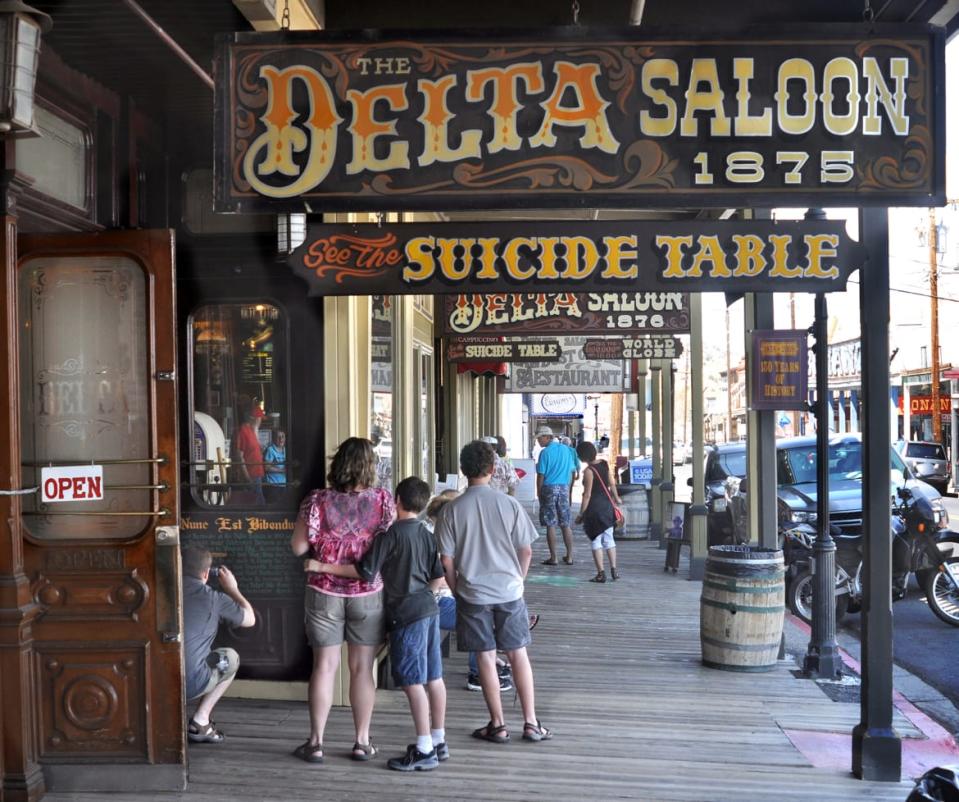
Tourists enjoy the attractions in Virginia City, Nevada, a gold and silver boomtown in the 1860s and 1870s.
History buffs should head to either the towering Second Empire-style restored Fourth Ward School for a lesson on the town and mining history or to the Mackay Mansion for a window into the life here of one of its mining kings. (Plus, there’s a fancy toilet likely used by both Ulysses S. Grant and Johnny Depp). The history here isn’t all a hundred years past or more. The Red Dog Saloon may serve up good pizza now, but back in the ‘60s it was the launching pad for the psychedelic music scene and bands like the Charlatans and Big Brother and the Holding Company.
Every leg on this trip seemed to take roughly 30 minutes driving, and closing it out by heading back to Reno’s airport was no different, as the airport sits just a half hour from this mining town perched on a mountainside. In less than a week I’d hit many of the items most would want in a trip–outdoors, beauty, food, history–and on the way to the airport I even saw something unexpected: wild horses.
Get the Daily Beast's biggest scoops and scandals delivered right to your inbox. Sign up now.
Stay informed and gain unlimited access to the Daily Beast's unmatched reporting. Subscribe now.

